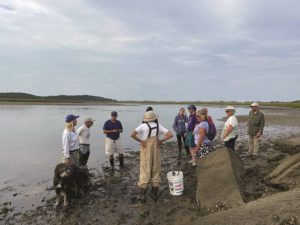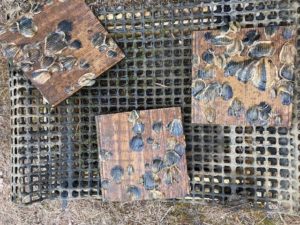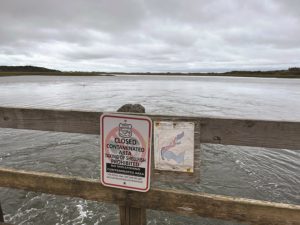WELLFLEET — In the late 1960s, the Chequessett Neck tide gate on the Herring River started to rust. As a result, the tide pushed through openings and into parts of the river that hadn’t been filled with salt water since the 900-foot dike was built in 1909.
With each tide, microscopic larvae produced by the millions of oysters in Wellfleet Harbor settled further upstream. Soon thereafter, according to Tidal Water: A History of Wellfleet’s Herring River, oysterman and poet Howard “Pokey” Snow came upon a significant population of oysters and soft-shell clams reestablishing themselves in the riverbed.
While shellfishermen and proponents of the river restoration project, led by writer Earlie Rich, rejoiced at the signs of salt-marsh grass and shellfish settling upstream, that return was short lived. In 1971, a divided town meeting voted 62-56 to rebuild the dike, citing flooding concerns on the Chequessett golf course and other private properties.
The saltwater habitat vanished.

For biologists who have studied the Herring River for decades, like Barbara Brennessel, the story of that breakthrough period helps describe not only what is to come once the restoration project begins but how quickly the changes will occur.
While there is knowledge of the historical herring runs that are predicted to return post-restoration, until recently little work had been done to predict what might happen to the wild oyster set or how the project will affect the larger health of the oyster population.
So, three years ago, Brennessel teamed up with ecologist John Portnoy, who had spent over 30 years studying salt marshes at the Cape Cod National Seashore, and Jackie Fouse of the Friends of Herring River to create a baseline study of wild oyster spat.
Last week, Brennessel, Portnoy, and Fouse were joined by a group of local residents as they completed their last day of data collection in the river. The data, to be presented at the annual State of Wellfleet Harbor Conference in November, will help predict how renewed tidal flow will affect the wild oysters.
Brennessel’s team deployed quarry tiles in five locations in and around the Herring River: a control site at the Puffer grant on Mayo Beach, Pebbly Bar in the Herring River estuary, a site just seaward of the dike, a site just landward of the dike, and one further upriver, known as the Dog Leg. The tiles would serve as landing pads for the clouds of spat (oyster larvae) produced each summer in mid to late June, when higher temperatures trigger oysters to release millions of sperm and eggs.
Oyster farmers often keep quarry tiles, or similar substrate, on their grants to collect oyster spat, which are then chipped off the tiles and put into mesh bags to grow to maturity.

Over the past three years, the researchers found that little to no spat attached to tiles after the beginning of July. The larvae landed mostly during a short window in June. This is evidence of earlier spawning, likely due to increased temperatures in the harbor, Brennessel said. Over time, that could have implications for shellfishermen, who rely on spat collection to grow oysters.
Most telling was a small set of spat that was collected just inland of the dike, which Brennessel said is a good sign for oysters moving upstream during the restoration process.
“In our furthest site upriver, we didn’t find any oysters at all because that water is so fresh,” she said. “But we did find oysters just inland of the dike, and once we restore the tide, and the salt water can get through, there very well may be more acres of oysters than we currently see.”
The best spat set was found in the subtidal flats just seaward of the dike. Chopper Young used to harvest oysters there in the 1980s, before the area was closed because of high acidity and fecal coliform contamination from wildlife. “Thousands of bushels live, die, and never get to be touched up there,” Young said. “It’s virgin ground.”
Today, only 10 acres of the original 1,100 acres of salt marsh remain. Above the dike, the Herring River has been listed as “impaired” under the Clean Water Act.
With increased cycling of water once the new bridge is built, scientists predict a drastic improvement in the water quality. Construction of the bridge is set to start this fall.
“Clean salt water from the bay will bring in that desperately needed infusion of oxygen, dilute bacteria concentration, and shorten the lifespan of the bacteria,” said Portnoy.

Experts predict an overall positive effect on the oysters in Wellfleet Harbor. Increased flow will allow them to filter more water and keep both the Herring River and the harbor clean, Brennessel said. It should also improve wild oyster productivity. “With more habitat for oysters to grow,” she said, “the entire oyster population that this industry relies on should really benefit.”
Aquaculturists in Wellfleet are cautiously optimistic about opening the dike. For them, the worry is whether there could be unforeseen consequences.
“Overall, we are pro-restoration because of the positive impact on the environment, town, and our industry,” said Zack Dixon, general manager of the Holbrook Oyster Company. “However, the project has been unwilling to establish any kind of fund or insurance for unforeseen consequences to our shellfish beds.”
One worry Dixon and others have raised is whether sediment transfer could cover their existing beds. But studies conducted over several decades by the Center for Coastal Studies and the National Seashore and hydrodynamic modeling of the river system conducted by the Woods Hole Group indicate that most sediment transportation will be upstream rather than toward oyster grants.
This upstream sediment deposition is part of what makes salt-marsh restoration projects important to long-term coastal resiliency. The upstream sedimentation allows the marsh to gain elevation, the better for facing down floods and sea-level rise.
Scientists have also found that channel velocities should work in the shellfishermen’s favor. They would be less than half the speed required to move sediment, except right at the dike — meaning any sediment movement toward the harbor would not spread far enough to reach the nearest shellfish grants.
Dixon says he and others don’t mistrust the science. “To be clear, I am actually pretty comfortable with this project and the science that has been done on sedimentation transfer,” he said. “It’s just that they’re unwilling to give us any type of assurances, except ‘We’ll stop if anything goes wrong.’ ”
That incremental approach is what project managers call “adaptive management.” Rather than opening the floodgates all at once, tidal flow will be restored in phases while scientists and managers monitor how the environment reacts to changes.
If there are unexpected system responses, said Herring River Restoration Project coordinator Carole Ridley, they should be detected early enough to make adjustments proactively.



